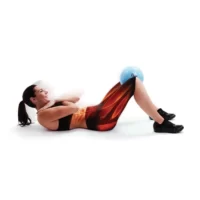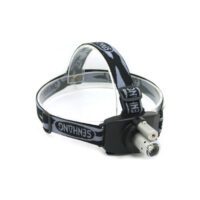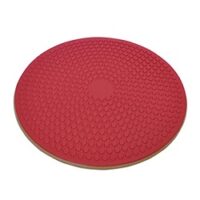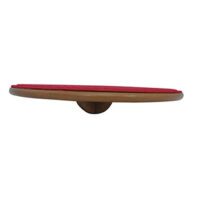Balance Training
Article by John Miller
Balance Training
What Exactly is “Balance”?
Balance is the body’s ability to maintain stability and control during movement or stillness. It relies on coordinated input from vision, the vestibular system, proprioception, and muscle strength to keep you steady and prevent falls.
What Influences Your Balance?
The five key components of balance are:
- Vision – Provides visual cues for orientation.
- Vestibular system – Senses head movement and gravity changes.
- Proprioception – Detects body position and movement through muscles and joints.
- Muscle strength – Supports stability and posture.
- Reaction time – Enables quick adjustments to maintain balance.
Together, these elements ensure proper coordination, stability, and balance in everyday activities.
Why Does Balance Deteriorate?
A person’s balance can deteriorate due to several factors affecting these five key components:
- Vision decline – Poor eyesight, such as from ageing or eye conditions, can reduce the ability to perceive surroundings and judge distances accurately.
- Vestibular dysfunction – Inner ear issues, such as vertigo or infections, can disrupt the vestibular system, leading to dizziness and imbalance.
- Impaired proprioception – Conditions like nerve damage or joint problems can affect the body’s ability to sense movement and position, making balance harder to maintain.
- Muscle weakness – Reduced muscle strength, particularly in the legs and core, can make it difficult to stabilise and control posture, increasing the risk of falls.
- Slower reaction time – Ageing or neurological conditions can slow down response times, making it harder to react quickly to sudden changes in balance.
These factors, individually or combined, can contribute to a decline in balance.
Symptoms of Poor Balance
Common symptoms of poor balance include:
- Dizziness or vertigo – A spinning sensation or feeling off-balance.
- Unsteady walking – Difficulty maintaining a steady gait or frequent stumbling.
- Frequent falls – Increased risk of tripping or falling.
- Disorientation – Feeling confused about body position or movement.
- Difficulty standing still – Swaying or needing to hold onto something for support.
- Blurred vision – Vision problems contributing to imbalance.
Balance Training
To improve balance by addressing the five key components:
- Vision – Ensure good lighting in your environment and consider vision correction if needed, as clear visual cues help orient the body and support balance.
- Vestibular System – Perform vestibular exercises like head-turning movements or walking in different directions to improve your inner ear’s ability to detect changes in motion and maintain balance.
- Proprioception – Practice balance exercises, such as standing on one leg or using balance boards, to sharpen your body’s awareness of its position and movement.
- Muscle Strength – Engage in strength training, focusing on leg and core muscles to provide the stability needed for maintaining balance.
- Reaction Time – Include agility drills and activities like catching or quick directional changes in your routine to improve your ability to react swiftly to changes, preventing falls and stumbles.
By targeting each of these components, you can build a stronger and more reliable sense of balance.
Who Can Help Improve Your Balance?
Several professionals can help improve your balance:
- Optometrists – Help address vision issues that might affect balance by correcting vision or offering advice on visual aids.
- Vestibular Physiotherapists – Focus on treating inner ear problems that affect balance, offering specific exercises to retrain the vestibular system.
- Exercise Physiotherapists – Provide personalised exercises and therapies to strengthen muscles, improve proprioception, improve reaction time and address balance issues caused by injury or conditions.
- Occupational therapists – Assist with adapting daily activities and environments to reduce fall risks and improve balance.
- Exercise Physiologists – Guide strength and balance training tailored to your needs.
- Podiatrists – Improve balance by addressing foot health issues that may affect stability.
- GP – Your GP is the key health professional to perform an overall assessment and assist the diagnosis of any underlying reason why you have impaired balance. They may refer you to other medical specialists such as a Neurologist depending upon their assessment.
Each of these professionals can provide tailored support based on the underlying cause of balance difficulties.
Balance Training: What Does PhysioWorks Offer?
At PhysioWorks, we offer a comprehensive range of services to help improve your balance:
- Personalised Physiotherapy Programs – Our physiotherapists assess your specific balance training needs and create customised exercise plans to improve muscle strength, proprioception, and overall stability.
- Vestibular Rehabilitation – Special treatments for those experiencing dizziness or balance problems due to inner ear conditions.
- Balance and Coordination Training – Targeted exercises designed to enhance proprioception and reaction time, reducing the risk of falls.
- Postural Assessment and Correction – We help improve your posture to support better balance and movement control.
- Strength and Flexibility Programs – Tailored routines focusing on core and leg strength, which are crucial for maintaining balance.
- Falls Prevention Programs – We offer specific programs aimed at reducing the risk of falls, incorporating balance training, muscle strengthening, and safety strategies.
Our experienced team works with you to address the specific causes of your balance problems and provide effective solutions to improve your stability and confidence.
Latest Research
In their 2023 systematic review, Sadaqa et al. examined the impact of exercise interventions on fall prevention among community-dwelling older adults. The review found that lower extremity strengthening, balance exercises, and multi-component exercise programs significantly improved muscle strength, balance, and mobility. These interventions also effectively reduced the rate of falls, fall-related injuries, and emergency department visits. Balance training was particularly effective in enhancing static, dynamic, and reactive balance. The authors concluded that exercise interventions are crucial in reducing falls and improving physical function in older adults, though further research is needed in low-income and vulnerable populations.
What to Do Next?
- Discuss with Your Doctor – Talk to your GP about your balance concerns and get their advice on the best approach.
- Book a Physio Balance Assessment – Schedule an assessment with one of our physiotherapists to evaluate your balance and identify any underlying issues.
- Discuss Your Concerns and Goals – During your assessment, share your specific concerns and balance goals so we can create a tailored treatment plan for you.
- Implement a Treatment Plan – Our team will work with you to implement a personalised program, helping you improve your balance and reduce the risk of falls.
Call us today to take the first step towards improved balance and fewer falls. Our team at PhysioWorks is here to help you regain stability, confidence, and control in your everyday life.
Rochedale - Call 38410277
Book Online: RochedaleSalisbury - Call 32751044
Book Online: SalisburySandgate - Call 32691122
Book Online: SandgateBalance Training FAQs
- Why is balance training important?
Balance training improves stability, reduces the risk of falls, and enhances coordination for daily activities and sports. - How often should I do balance training?
Aim to incorporate balance exercises into your routine 2-3 times a week for optimal results. - What exercises improve balance?
Common exercises include standing on one leg, using a balance board, and practising yoga or Tai Chi. - Who needs balance training?
Balance training benefits people of all ages, including older adults, athletes, and those recovering from injuries. - When should I start balance training?
It’s never too early or too late to begin balance training. Starting now can help prevent future issues. Read more: When is the Best Time to Start Balance Training? - How does balance training prevent falls?
Balance exercises strengthen muscles, improve reaction times, and enhance coordination, reducing your risk of falling. Read more: How Balance Training Can Prevent Falls - What equipment do I need for balance training?
You can start with simple tools like a balance board, stability ball, or no equipment at all. - Where can I do balance training exercises?
Balance exercises can be performed at home, at the gym, or in a specialised rehabilitation centre. - What is proprioception in balance training?
Proprioception refers to your body’s awareness of its position in space, and it’s a key aspect of balance training. - How long does it take to see results from balance training?
Consistent practice over several weeks typically results in noticeable improvements in stability and coordination.
Social Media Follow Us
For more balance training tips and exercises, follow us on social media. We share advice and exercises that can help improve your balance and prevent falls.



















